Now your text follows basic format conventions (Chapter 2.1), is well structured and coherent (Chapter 2.2), and is well supported by an accurately represented reference base (Chapter 2.3). You have even expressed your work in clear, efficient, correctly punctuated sentences (Chapter 2.4). There are a few hurdles left, however—professional hurdles. A reader can understand your text if quotations are handled incorrectly: At least the words are still there. But professionals (including professors) will not be impressed with your performance; the sloppiness is somewhat comparable to arriving on the other side of the hurdle but knocking it over in the process. And there are some slips with handling quotations that can get you sidelined with ethics issues as well. Correct handling of lists and series and of verb forms and tenses are not so risky with ethics, but errors often result in a sprawling jumbled mess that does not represent you well. Like the hurdler, you need a clean, skillful performance, with no sloppy distractions to discredit you. Mechanics is the least important aspect of writing, but errors can prejudice a reader and interfere with the ways the more important aspects are received.
Quotations 1: Keeping Bounds Safe and Accurate
It’s a good thing that not more than 10% of your masterpiece will be in the form of direct quotations (see Chapter 6), because there are so many little details to keep track of when quoting someone else’s words. There are a number of hazards—conventions that are easy to miss. Also there are a number of tools—devices you can use to make quotations more applicable to your text and clearer to your reader.
Challenge 1: Select Quotations Carefully and Be Sure You Understand Them
When you recognize that an author is using key words about your topic, it’s tempting to take a chunk with a nice-sounding sentence or two, put quotation marks around it, and just slip it into a skimpy paragraph. But this isn’t very safe. Be sure you understand not only what the words mean but what the author means by them.
Engage in mental discipline. Don’t quote to avoid having to paraphrase. Don’t quote anything you haven’t paraphrased first in your own mind in terms of your approach and in consideration of the other information you plan to use around it.
Challenge 2: Format Quotations Correctly
In formatting quotations, you are playing a numbers game. For APA format, you will incorporate.
Incorporated quotations are introduced coherently, set off by quotation marks, and typed carefully into the paragraph. They may be handled in several ways.
- Introduced by a complete statement. Q.W. Johnson’s (2002) statement has become classic: “Xxxx xxxxxx xxx xxx” (p. 27).
- Set off with a speaker tag. Smith (2015) commented, “Xxxx xxxx xxxx” (p. 47).
- Embedded in the sentence. Rothman’s opinion was “xxxx xxx xxx” (2015, p. 4).

Small Stuff
Short quotations (less than 40 words) are incorporated into the text as smoothly and naturally as possible (see examples above). Don’t just shove them in abruptly so that they are awkward and intrusive.
Big Stuff
Quotations of 40 words or more are blocked: indented on the left 5 to 7 spaces, the same number of spaces as the paragraphs.
Quotation marks are NOT used in a blocked quotation. The blocking takes the place of quotation marks.

Use common sense in choosing the introduction and punctuation marks that precede block quotes.
Some authors occasionally embed a long quotation within a sentence and as a result have a block without punctuation or capital. But it looks a little weird, and some handbooks explicitly discourage it. For the sake of your reader’s sense of visual balance, just introduce with a complete statement or a speaker tag. It doesn’t take too much energy to type in “Jones concluded,” or “Smith explained.”
Longer quotations may stand by themselves in the middle of the page, but the meaning should still be worked in smoothly with the rest of the text. Tie them in clearly and coherently with the text that comes before (“Jones gives an example,” “Smith suggests an application,” “Brown offers a caution”). After the quotation, move smoothly into the rest of the text (“An additional consideration,” “A contrasting situation,” “A further result”). Don’t leave a conspicuous participant alone and unconnected.
Challenge 3: Introduce Quotations Ethically and Appropriately
Not only is an unintroduced quotation awkward, it can be confusing and may lead to accidental plagiarism. A reader must be able to tell easily who said what, as well as whether a quotation following a paraphrase is by the same or a different author. If you’re tired of using the same old “he said” speaker tags, here are a few others—courtesy of the author’s memory, along with a number of thesauruses.
Speaker Tags and Other Useful Quote Labels
- acknowledges
- advocates
- affirms
- agrees
- allows
- announces
- establishes
- argues
- asserts
- analyzes
- calls attention to
- concludes
- comments
- cites
- clarifies
- describes
- defends
- references
- shares
- explains
- comments
- gives a summary
- disagrees
- discusses
- elucidates
- enlightens
- gives an opinion
- gives an explanation
- gives an understanding
- gives a justification
- gives an analysis
- justifies
- informs
- implies
- interprets
- infers
- reviews
- makes a case
- makes a statement
- makes an observation
- makes note of
- makes a point
- makes a comment
- makes reference to
- makes sense of
- records
- refers
- notes
- remarks
- states
- says!
Challenge 4: Place Concluding Punctuation and Citations Correctly
Getting out of quotations can be as sticky as getting into them. There are conventions that need to be followed—not because they are particularly striking or sensible, but because they are expected.
Give page numbers for all direct quotations.
- For quotations incorporated in paragraphs, the most common position is at the end of the quotation immediately following quotation marks, preceding the period (as shown above).
- For quotations that are blocked, place the page number outside the period.
For incorporated quotations that do not end in a citation, usage specifies placement of end punctuation with quotation marks.

Remember that the little ones go inside, and the tall ones go outside. Actually this is the reason—not a teacher’s made-up memory device. Printers thought the text looked better.
IT’S A MATTER OF INTERPRETATION. As often happens, question marks and exclamation points are in a class by themselves. They go inside or outside the quotation marks depending on whether the overall statement or just the quoted material is a question or exclamation.
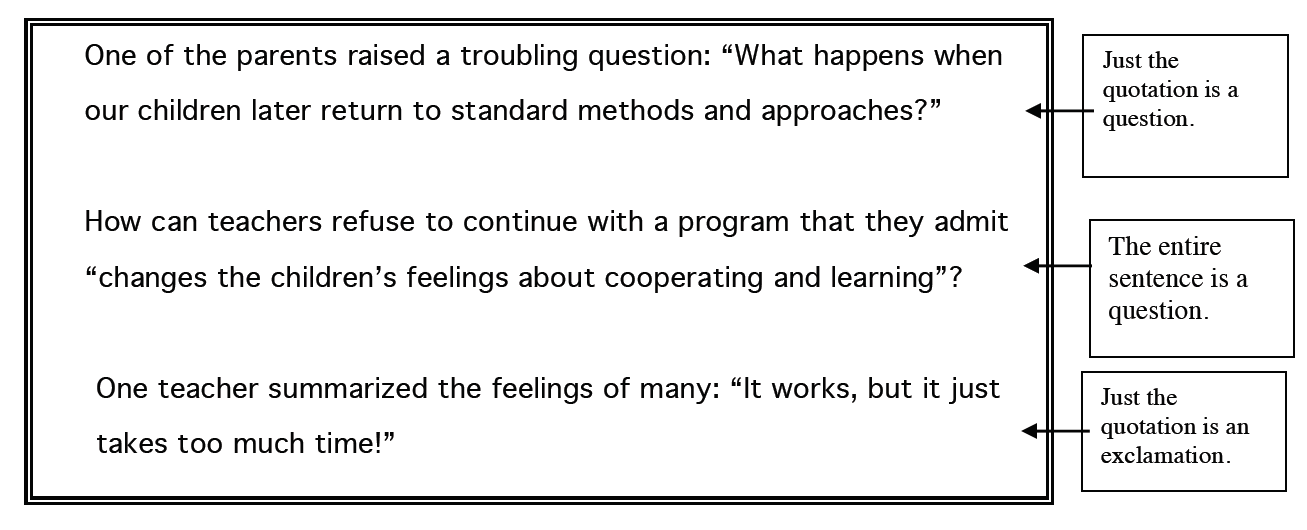
Challenge 5: Use Single Quotation Marks Correctly
Use single quotation marks ONLY for a quotation within a quotation that is enclosed in standard double marks.
Rumors have started somewhere that single quotation marks are a more artistic alternative to standard marks or that they should be used for short quotations. But neither is true—at least not in U.S. usage.
Single marks are only for internal quotes that would require confusing sets of marks. You can think of them as the inside set.
Goodlad (1990) discusses the importance of teachers reflecting on and engaging in dialogue regarding moral principles. “Such teachers and their calling,” he comments, “warrant the designation ‘professional’” (p. 28).
Use standard quotation marks for quotations within blocked quotations, since there is no outer set of marks (no conflict of interest, if you want to look at it that way).
Quotations 2: Making Necessary Adaptations
Adaptation 1: Use Square Brackets for Necessary Additions and Changes
Use brackets to keep things sorted and make relationships clear. You can think of them as little memos to help the reader see things more accurately.
Use brackets to fill in necessary information that does not appear in the segment you quote.
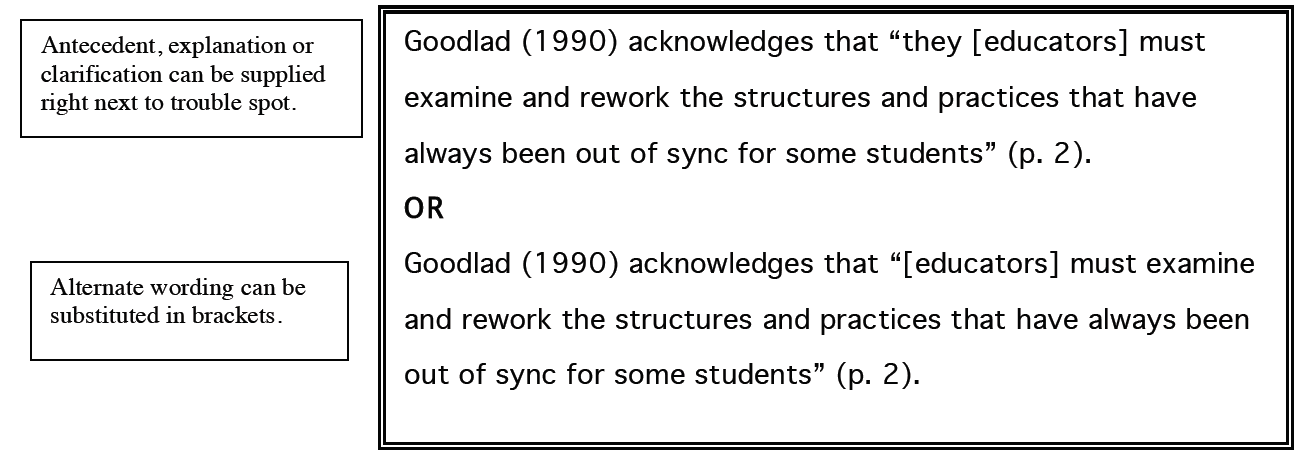
Use brackets to make minor changes in the text that will help it fit better into your use of it.

- Brackets are often used to change tense to fit more coherently with the text.
- Changes in singulars and plurals are also often made in this way.
Use brackets to acknowledge added emphasis to a quotation.
As Goodlad (1990) affirms, “Educators must rethink what education is, what schools are for [italics added]” (p. 2).
Use [sic] to indicate an error in the original.
(He is the one who is sic.—not I)
Even authors and publishers have bad days, and sometimes you will find a mistake in a text that you are quoting. It this is likely to confuse your readers, use sic (Latin for thus) to show that the error isn’t yours. You do not need to do this if you are quoting dialogue or presenting something written by a young child or a person with a disability. In such cases the source of the error is obvious.
As R.J. Malinsky (2003) explained, “The gains were immediate and striking; however, weather [sic] the differences will be lasting is not evident” (p. 70).
Adaptation 2: Use Ellipses to Omit Unnecessary Bulk from Quotations
Sometimes defenders and advocates get overly repetitious and wordy. And often they veer off in directions that don’t interest you at all. When you’re quoting their words in print, you can eliminate unnecessary bulk or irrelevant comments by using ellipsis (three spaced periods) to indicate your omission.
Use three spaced periods (. . . ) to indicate that words have been left out of the middle of a sentence.
Use four spaced periods (ellipsis plus period) to indicate that the words left out have ended a sentence.

Do not use ellipsis to indicate something left out at the beginning or end of a quotation.
Ellipsis used to be used before or after a quotation to indicate that the writer had broken into the middle of a sentence or stopped before the end of a sentence. This was changed more than 20 years ago. Neither opening or closing ellipsis is currently used.
Correct
Goodlad (1990) proposes that since almost all of us teach, “perhaps all of us should be taught something about it” (p. 3).
Out of Date
Goodlad (1990) proposes that since most of us teach “ . . . perhaps all of us should be taught something about it” (p. 3).
Just a word on ethics: You can’t use ellipsis or brackets to make an author say something he or she did not intend. You can’t say—
The Bible says, “Thou shalt . . . commit adultery.”
The Bible says, “Thou shalt [not] love thy neighbor as thyself.
Seriation: Handling Appropriate and Inappropriate Alliances
As humans we tend to like to clump things into groups and series. Doing so seems to give us a sense that we are in control. Sometimes this is true; other times we are just clumping things. In an important paper, thesis, or dissertation, the writer must manage clearly and efficiently—clumping is not an option for those who do not like rewriting and resubmitting. Here are a few hints for both managing and presenting potential series items.
Management Factor 1: Be Sure that Series Items Actually Belong in the Series
The Publication Manual of the American Psychological Association says that items in a series must be “conceptually parallel” and grammatically parallel as well (2001, p. 117).
Basically conceptually parallel means that you do not make a series out of apples, oranges, and broccoli—or worse still, apples, oranges, and automobiles. The meaning represented by the series items must be comparable.

Management Factor 2: Put Series in Grammatically Parallel Form
If items are the same kind of material, you should be able to put them in the same basic mold. If one or more of the items cannot be adapted to the method or materials of shaping, it may belong in a different group. Grammatical form is a way of shaping statements. If they are not the same kind of statement, they probably will not shape out the same way.
Try to adapt the pattern of expression to make the items fit.
- If you can’t make them fit, check to see if they should fit—if they really belong as part of the series.
- If an item or items do not belong, split the series.

Does it matter? Actually it does. People respond consciously or subconsciously to rhythm in thought and in language. William Strunk Jr. and E.B. White, whose 1959 book The Elements of Style is still the “bible” for many skilled writers, explained, “The likeness of form enables the reader to recognize more readily the likeness of content and function” (p. 26).
Readers might not have the terminology or the inclination to think, “Yuk—nonparallel,” but they won’t processes as smoothly or recall things as well. Nonparallel seriation just “feels” wrong. People who can’t tell you the musical intervals involved in a dischord can still tell that something is wrong with the way the notes go together. Same thing.
Management Factor 3: Select the Most Effective Format for Series and Lists
Format depends on the size, nature, complexity, and purpose of the grouping.
A short, relatively simple series can usually be put in a horizontal list.
Things that are brief, tightly connected, and carefully coordinated don’t need much space for the reader to process them easily.
Series items that are more complex or need more emphasis—but still are not terribly long or detailed—can be placed in a horizontal list with series markers. APA format specifies that series items within a sentence or paragraph should be lettered rather than numbered.

Lists that are quite long and complex will be clearer and more emphatic if set off in hanging indent form.
- Use numbers rather than letters, and consider each item as a separate paragraph.
- Items on the list need to be parallel in concept and function and at least basically parallel in grammatical form. As with shorter lists, if they are conceptually parallel, they should be reasonably easy to cast in parallel structure.
This list seems to go in a number of different directions. The differences in grammatical structure of the hastily compiled inferences from data seem to reflect different kinds of information, although all were obtained in response to the same question. All seem to be characteristic actions; thus they could possibly be cast in parallel form as actions.
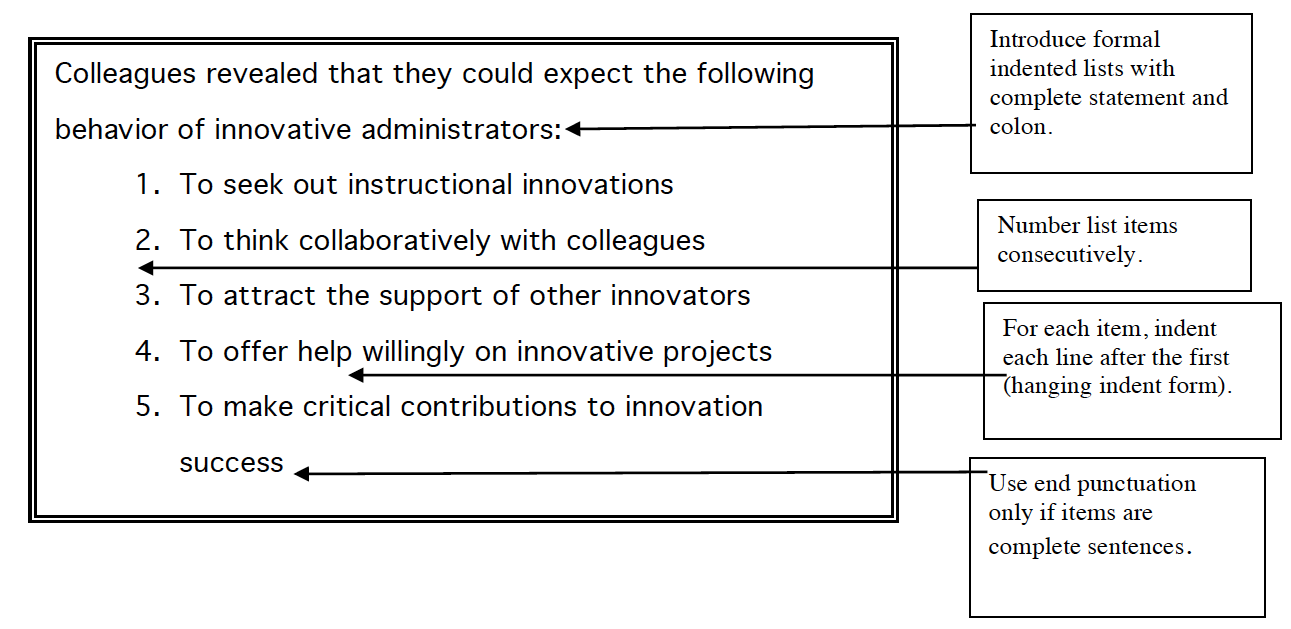
If items on the list are short and are clearly grammatical continuations of the sentence, they may be listed without capitalization and followed by commas or semicolons (as appropriate), with a period after the final item. This format is allowed by APA but not used by as many writers as the one above.
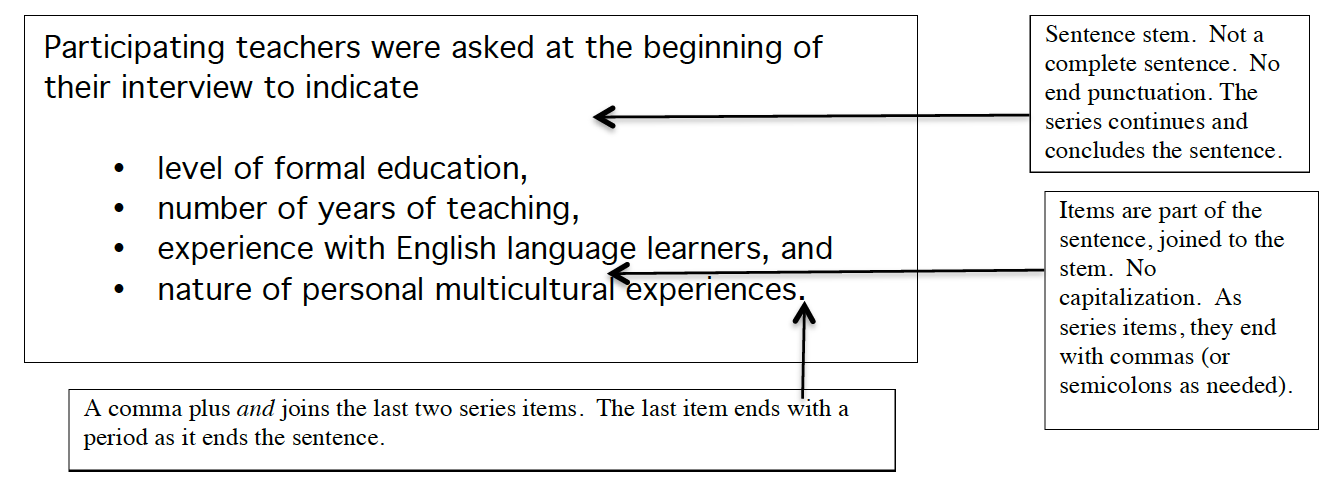
Do not combine the formats and use commas or semicolons after capitalized fragments
Management Factor 4: Remember that a Pair is Also a Series
Pairs must be parallel as well. Remember that a series of two still represents items with the same function and thus requires the same grammatical format. Be sure that the conjunction (or pair of conjunctions) is the balance point between the parallel items.
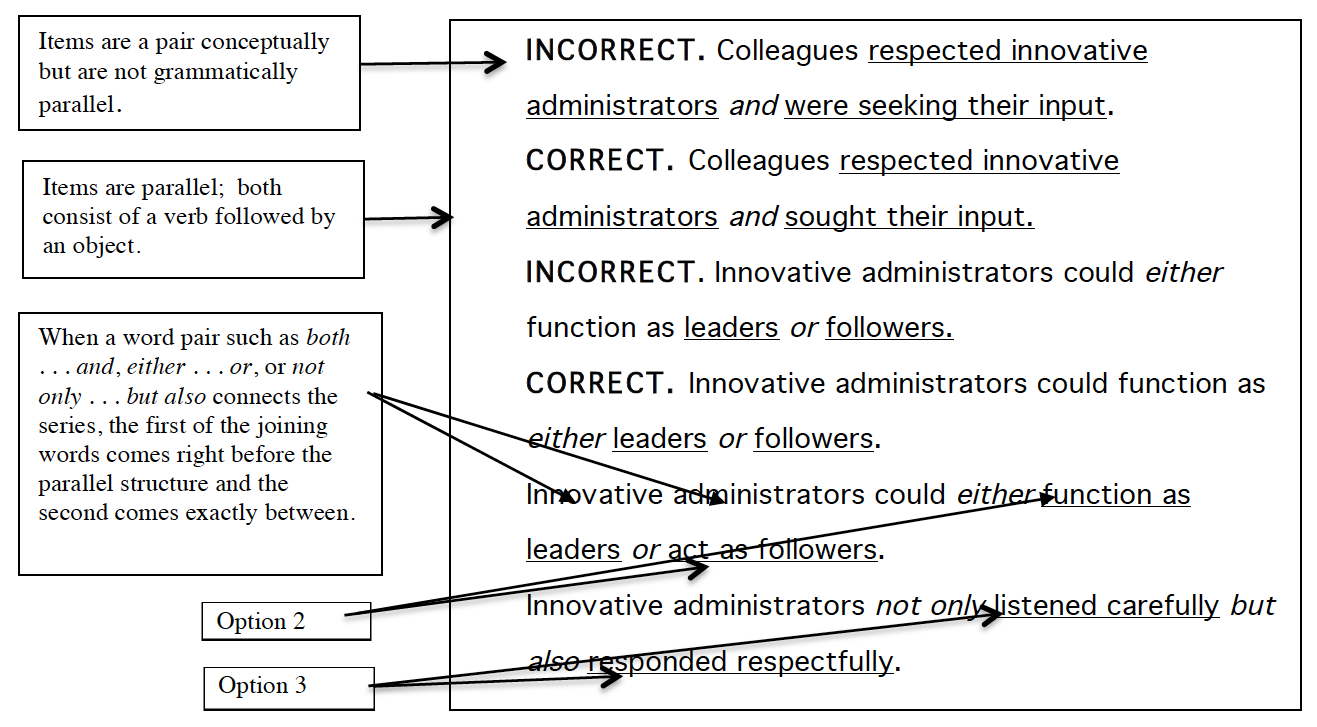
Verb Use: Keeping Verbs and Verb Forms Straight
Consideration 1: Use Active and Passive Voice Appropriately
Active is more active. But passive does have its uses.
Learn the distinction between active and passive voice.
- In active voice, the subject acts: Jones and Brown conducted the experiment.
- In passive voice, the subject receives rather than initiates action: The study was conducted by Jones and Brown.
Recognize common misconceptions.
If you’ve heard that research should never be reported in passive voice or that research must be reported mostly in passive voice, use your mental eraser. Both are somewhat common conceptions, and both are misconceptions.
Learn appropriate uses for active and passive voice.
- Active voice emphasizes agent and action.
- Passive voice deemphasizes or even conceals agent.
Active voice should be used for most sentences; however passive voice can be useful when you know what you are doing. Passive voice is heavier and wordier than active. Do not overuse passive voice.

Don’t let your writing become too weighted down. It’s sometimes tempting to let passive predominate, particularly in methods sections. But too much passive voice makes your writing flat and wordy. Even if you have a reason for trying to avoid first person, use active voice as much as you can (e.g., “The first and second author interviewed 25 of the 200 participants.”).
Consideration 2: Select Your Verb Tenses Carefully
No matter how you set up your questions, answers, perspectives, and conclusions, you have to keep the sequences consistent and logical: a.k.a. watch out for tense use—one of the most common slip- up areas in academic writing.
Select basic tenses for the sections by applying APA suggestions. In reading a variety of books and articles on your topic, you will see tenses and tense sequences handled in different ways. The American Psychological Association (2010) suggests the following general guidelines (pp. 33, 42, 43).
APA Suggestions for Using Tense in Various Sections and Circumstances
|
Use
|
Tense
|
Reason
|
|
Something that has occurred at definite time in the past
|
Past
|
What is reported has already happened.
|
|
Review of literature
|
Past or present perfect
|
Research has already taken place either at one time (past tense) or continuously over time (present perfect).
|
|
Procedures
|
Past or present perfect
|
Procedure has already taken place (past) or began in the past and continues (present perfect).
|
|
Results
|
Past
|
Results were discerned and analyzed in the past.
|
|
Conclusions
|
Present
|
Present tense invites the reader to join in deliberation. If you are reporting them as current, we assume they are still true. Conclusions can also be reported in present perfect
|
Vary tenses as necessary for shades of meaning; be aware of how to use the perfect tenses as well as simple past, present, and future.
Use present perfect for something that began in the past and extends into the present.
During the three years of the experiment, subjects have shown steady progress in their ability to master the target skills.
Since the turn of the century, researchers have undertaken a variety of studies concerned with this topic.
Use past perfect for something that happened prior to past time being discussed.
After the subjects had completed the preliminary assessment instrument, the researchers began to implement the baseline phase of the study.
After Stein had publicized his findings, additional researchers undertook further experimentation.
Use future perfect for something that will have happened prior to a predicted future time.
By the time the procedures specified in the grant have been completed, more than 4,000 children will have had an opportunity to participate in a science fair project.
We predict that when the students have completed the treatment program they will have progressed at least two grade levels in reading.
Consideration 3: Be Sure that Verbs Agree with their Subjects
Sometimes when you are dealing with multiple individuals and/or complex actions, you may have to remove the packaging to figure out what the REAL subject is.
Intervening words or phrases do not change the subject-verb relationship. This goes back to the core question of who really did what.
Interview Subject 4, among the 47 assigned to the control group, was able to advance almost a full grade level during the first three months of the study.
The first teacher to implement the program, as well as many of her colleagues who were later inducted into the study, was enthusiastic about the results in her classroom.
Compound subjects are plural.
The first author and the trained undergraduate assistant were responsible for taking extensive field notes during all classroom sessions.
Both the self-report questionnaire and the interview transcription were used to assess each participant’s reaction.
Collective nouns (class, group, or other unit) can be treated as singular or plural depending on whether it is the group as a unit or members of the group as diverse individuals who are affected.
The faculty was united in enthusiasm for the intervention (unit together).
The group of parents were diverse and unsettled in their thinking (group functioning as individuals).
If subjects are joined by or or nor and one is singular and the other plural, the verb agrees with the subject that is closer.
Neither the teacher nor the students were adequately prepared for the project.
The parents or the teacher has to assume responsibility for reporting.
If you can handle quotations, seriation/parallelism, and verb problems, you should be able to avoid some of the most common errors made by undergraduate and graduate students—and by some more experienced academic writers as well. These conventions and uses may seem to be superficial distinctions that should be relatively unimportant in completing your paper, article, thesis, or dissertation. Compared to your content, of course, they are. But failing to follow the conventions of good grammar and usage can make you appear clumsy and non-professional—labels none of us can afford.
None of these rules or distinctions is difficult. They are relatively easy to apply during the drafting and/or editing process.
The next chapter goes into some of the smaller, stickier grammatical distinctions. Many of them are sets of practices and rules that you will want to be able to look up when you need them rather than memorizing them all. Just consult the Publication Manual of the American Psychological Association (2010) or this online handbook when you need one of them. Memorize the rules and distinctions that you need most and use most frequently. Learn approximately where to find the others so you can look them up when you want them.